Berg J.M., Tymoczko J.L., Stryer L. Biochemistry
Подождите немного. Документ загружается.

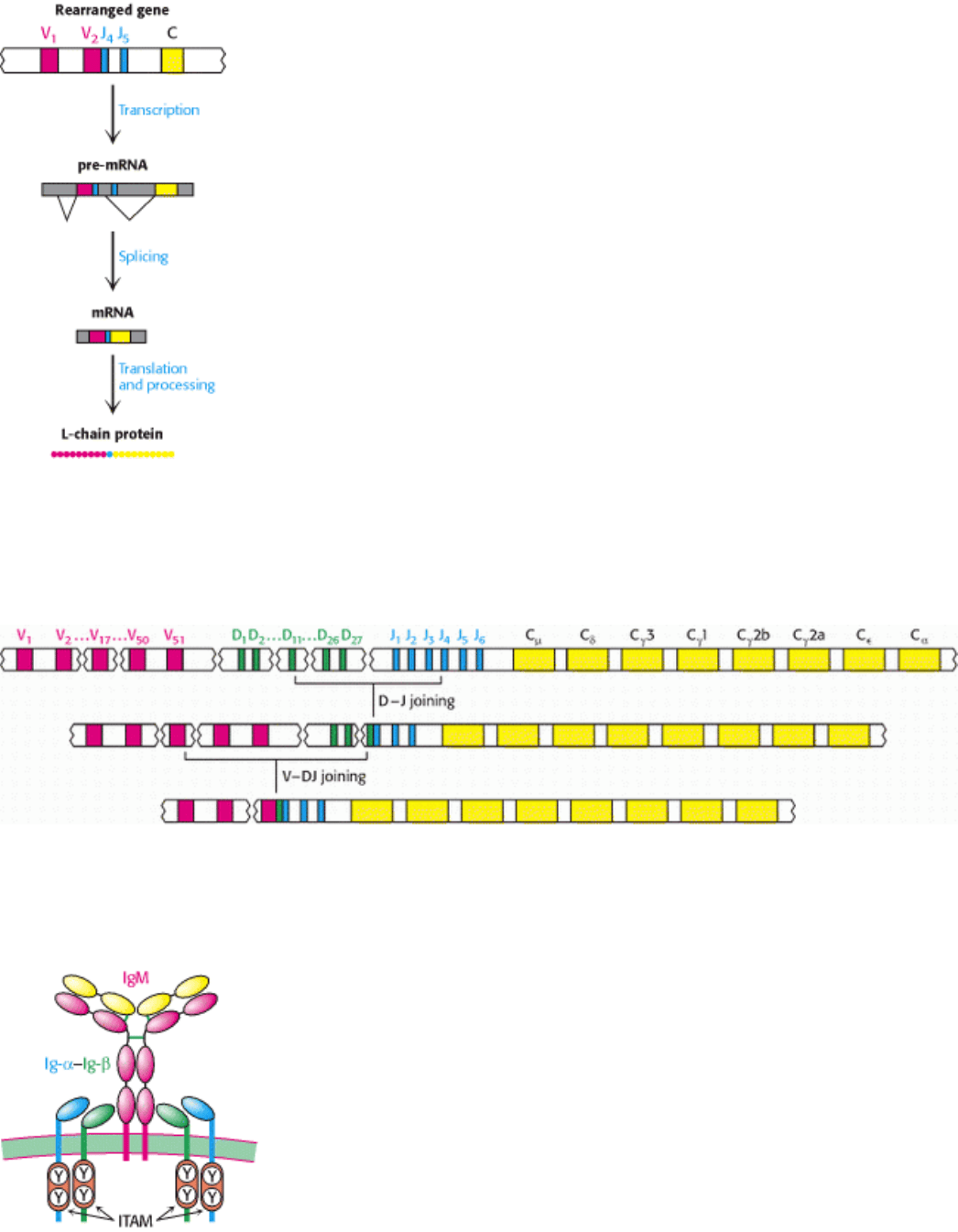
IV. Responding to Environmental Changes 33. The Immune System 33.4. Diversity Is Generated by Gene Rearrangements
Figure 33.16. Light-Chain Expression. The light-chain protein is expressed by transcription of the rearranged gene to
produce a pre-RNA molecule with the VJ and C regions separated. RNA splicing removes the intervening sequences to
produce an mRNA molecule with the VJ and C regions linked. Translation of the mRNA and processing of the initial
protein product produces the light chain.
IV. Responding to Environmental Changes 33. The Immune System 33.4. Diversity Is Generated by Gene Rearrangements
Figure 33.17. V( D ) J Recombination. The heavy-chain locus includes an array of 51 V segments, 27 D segments, and
6 J segments. Gene rearrangement begins with D-J joining, followed by further rearrangement to link the V segment to
the DJ segment.
IV. Responding to Environmental Changes 33. The Immune System 33.4. Diversity Is Generated by Gene Rearrangements
Figure 33.18. B-Cell Receptor. This complex consists of a membrane-bound IgM molecule noncovalently bound to two
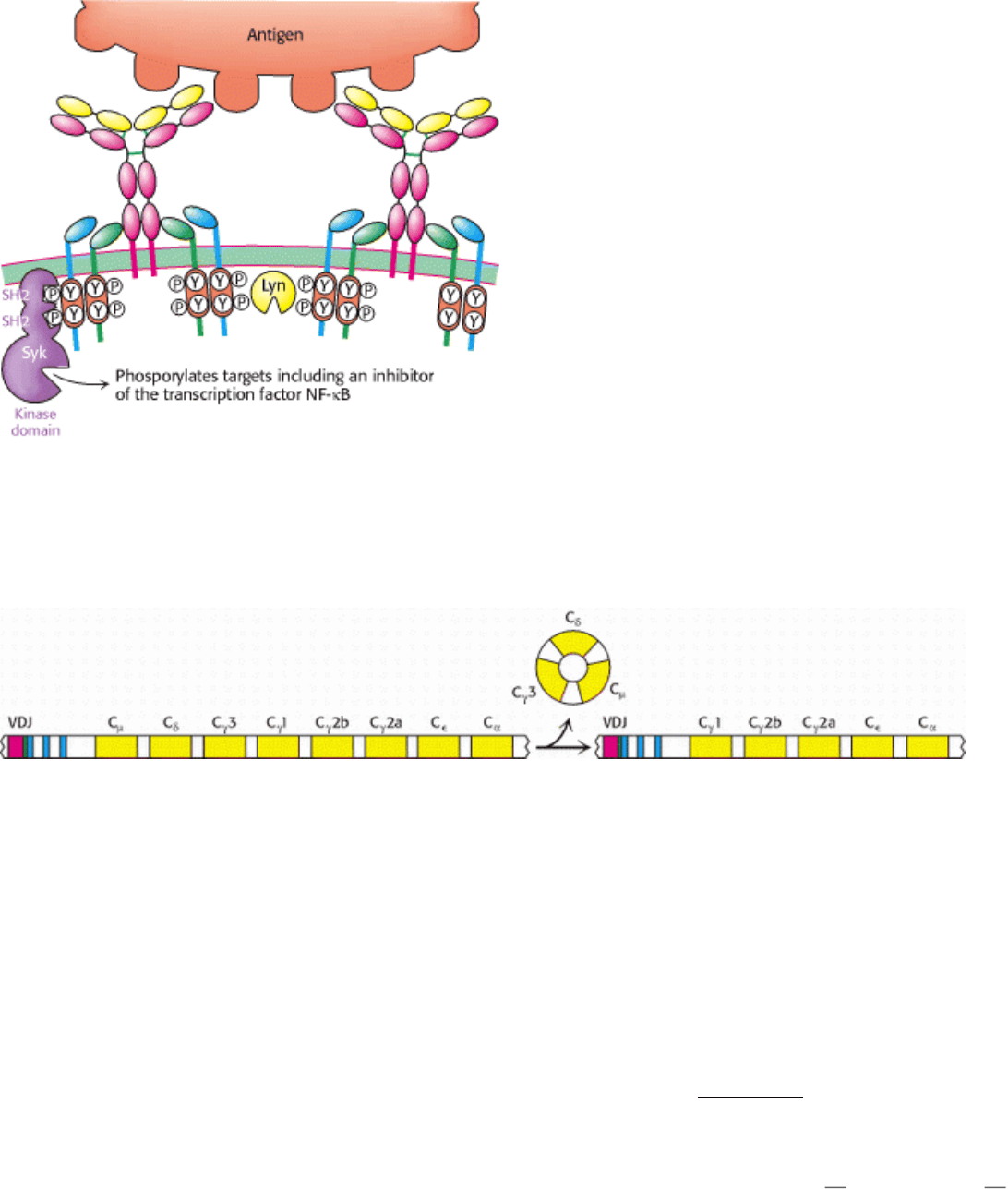
Ig-α-Ig-β heterodimers. The intracellular domains of each of the Ig-α and Ig-β chains include an immunoreceptor
tyrosine-based activation motif (ITAM).
IV. Responding to Environmental Changes 33. The Immune System 33.4. Diversity Is Generated by Gene Rearrangements
Figure 33.19. B-Cell Activation. The binding of multivalent antigen such as bacterial or viral surfaces links membrane-
bound IgM molecules. This oligomerization triggers the phosphorylation of tyrosine residues in the ITAM sequences by
protein tyrosine kinases such as Lyn. After phosphorylation, the ITAMs serve as docking sites for Syk, a protein kinase
that phosphorylates a number of targets, including transcription factors.
IV. Responding to Environmental Changes 33. The Immune System 33.4. Diversity Is Generated by Gene Rearrangements
Figure 33.20. Class Switching. Further rearrangement of the heavy-chain locus results in the generation of genes for
anti-body classes other than IgM. In the case shown, rearrangement places the VDJ region next to the Cγ1 region,
resulting in the production of IgG1. Note that no further rearrangement of the VDJ region takes place, so the specificity
of the anti-body is not affected.
IV. Responding to Environmental Changes 33. The Immune System
33.5. Major-Histocompatibility-Complex Proteins Present Peptide Antigens on Cell
Surfaces for Recognition by T-Cell Receptors
Soluble antibodies are highly effective against extracellular pathogens, but they confer little protection against
microorganisms that are predominantly intracellular, such as viruses and mycobacteria (which cause tuberculosis and
leprosy). These pathogens are shielded from antibodies by the host-cell membrane (Figure 33.21). A different and more
subtle strategy, cell-mediated immunity, evolved to cope with intracellular pathogens. T cells continually scan the
surfaces of all cells and kill those that exhibit foreign markings. The task is not simple; intracellular microorganisms are
not so obliging as to intentionally leave telltale traces on the surface of their host. Quite the contrary, successful
pathogens are masters of the art of camouflage. Vertebrates have devised an ingenious mechanism cut and display
to reveal the presence of stealthy intruders. Nearly all vertebrate cells exhibit on their surfaces a sample of peptides
derived from the digestion of proteins in their cytosol. These peptides are displayed by integral membrane proteins that

are encoded by the major histocompatibility complex (MHC). Specifically, peptides derived from cytosolic proteins are
bound to class I MHC proteins.
How are these peptides generated and delivered to the plasma membrane? The process starts in the cytosol with the
degradation of proteins, self proteins as well as those of pathogens (Figure 33.22). Digestion is carried out by
proteasomes (Section 23.2.2). The resulting peptide fragments are transported from the cytosol into the lumen of the
endoplasmic reticulum by an ATP-driven pump. In the ER, peptides combine with nascent class I MHC proteins; these
complexes are then targeted to the plasma membrane.
MHC proteins embedded in the plasma membrane tenaciously grip their bound peptides so that they can be touched and
scrutinized by T-cell receptors on the surface of a killer cell. Foreign peptides bound to class I MHC proteins signal that
a cell is infected and mark it for destruction by cytotoxic T cells. An assembly consisting of the foreign peptide-MHC
complex, the T-cell receptor, and numerous accessory proteins triggers a cascade that induces apoptosis in the infected
cell. Strictly speaking, infected cells are not killed but, instead, are triggered to commit suicide to aid the organism.
33.5.1. Peptides Presented by MHC Proteins Occupy a Deep Groove Flanked by Alpha
Helices
The three-dimensional structure of a large fragment of a human MHC class I protein, human leukocyte antigen A2 (HLA-
A2), was solved in 1987 by Don Wiley and Pamela Bjorkman. Class I MHC proteins consist of a 44-kd α chain
noncovalently bound to a 12-kd polypeptide called β
2
- microglobulin. The α chain has three extracellular domains (α
1
,
α
2
, and α
3
), a transmembrane segment, and a tail that extends into the cytosol (Figure 33.23). Cleavage by papain of
the HLA α chain several residues before the transmembrane segment yielded a soluble heterodimeric fragment. The β
2
-
microglobulin subunit and the α
3
domains have immunoglobulin folds, although the pairing of the two domains differs
from that in antibodies. The α
1
and α
2
domains exhibit a novel and remarkable architecture. They associate intimately
to form a deep groove that serves as the peptide-binding site (Figure 33.24). The floor of the groove, which is about 25 Å
long and 10 Å wide, is formed by eight β strands, four from each domain. A long helix contributed by the α
1
domain
forms one side, and a helix contributed by the α
2
domain forms the other side. This groove is the binding site for the
presentation of peptides.
The groove can be filled by a peptide from 8 to 10 residues long in an extended conformation. As we shall see (Section
33.5.6), MHC proteins are remarkably diverse in the human population; each person expresses as many as six distinct
class I MHC proteins and many different forms are present in different people. The first structure determined, HLA-A2,
binds peptides that almost always have leucine in the second position and valine in the last position (Figure 33.25). Side
chains from the MHC molecule interact with the amino and carboxyl termini and with the side chains in these two key
positions. These residues are often referred to as the anchor residues. The other residues are highly variable. Thus, many
millions of different peptides can be presented by this particular class I MHC protein; the identities of only two of the
nine residues are crucial for binding. Each class of MHC molecules requires a unique set of anchor residues. Thus, a
tremendous range of peptides can be presented by these molecules. Note that one face of the bound peptide is exposed to
solution where it can be examined by other molecules, particularly T-cell receptors. An additional remarkable feature of
MHC-peptide complexes is their kinetic stability; once bound, a peptide is not released, even over a period of days.
33.5.2. T-Cell Receptors Are Antibody-like Proteins Containing Variable and Constant
Regions
We are now ready to consider the receptor that recognizes peptides displayed by MHC proteins on target cells. The T-
cell receptor consists of a 43-kd α chain (T
α
) joined by a disulfide bond to a 43-kd β chain (T
β
; Figure 33.26). Each
chain spans the plasma membrane and has a short carboxyl-terminal region on the cytosolic side. A small proportion of
T cells express a receptor consisting of γ and δ chains in place of α and β. T
α
and T
β
, like immunoglobulin L and H

chains, consist of variable and constant regions. Indeed, these domains of the T-cell receptor are homologous to the V
and C domains of immunoglobulins. Furthermore, hypervariable sequences present in the V regions of T
α
and T
β
form
the binding site for the epitope.
The genetic architecture of these proteins is similar to that of immunoglobulins. The variable region of T
α
is encoded by
about 50 Vsegment genes and 70 J-segment genes. T
β
is encoded by two D-segment genes in addition to 57 V and 13 J-
segment genes. Again, the diversity of component genes and the use of slightly imprecise modes of joining them
increase the number of distinct proteins formed. At least 10
12
different specificities could arise from combinations of this
repertoire of genes. Thus, T-cell receptors, like immunoglobulins, can recognize a very large number of different
epitopes. All the receptors on a particular T cell have the same specificity.
How do T cells recognize their targets? The variable regions of the α and β chains of the T-cell receptor form a binding
site that recognizes a combined epitope-foreign peptide bound to an MHC protein (Figure 33.27). Neither the foreign
peptide alone nor the MHC protein alone forms a complex with the T-cell receptor. Thus, fragments of an intracellular
pathogen are presented in a context that allows them to be detected, leading to the initiation of an appropriate response.
33.5.3. CD8 on Cytotoxic T Cells Acts in Concert with T-Cell Receptors
The T-cell receptor does not act alone in recognizing and mediating the fate of target cells. Cytotoxic T cells also express
a protein termed CD8 on their surfaces that is crucial for the recognition of the class I MHC-peptide complex. The
abbreviation CD stands for cluster of differentiation, referring to a cell-surface marker that is used to identify a lineage or
stage of differentiation. Antibodies specific for particular CD proteins have been invaluable in following the
development of leukocytes and in discovering new interactions between specific cell types.
Each chain in the CD8 dimer contains a domain that resembles an immunoglobulin variable domain (Figure 33.28). CD8
interacts primarily with the relatively constant α
3
domain of class I MHC proteins. This interaction further stabilizes the
interactions between the T cell and its target. The cytosolic tail of CD8 contains a docking site for Lck, a cytosolic
tyrosine kinase akin to Src. The T-cell receptor itself is associated with six polypeptides that form the CD3 complex
(Figure 33.29). The γ, δ, and ε chains of CD3 are homologous to Ig-α and Ig-β associated with the B-cell receptor
(Section 33.4.3); each chain consists of an extracellular immunoglobulin domain and an intracellular ITAM region.
These chains associate into CD3 γ ε and CD3 δ ε heterodimers. An additional component, the CD3 ζ chain, has only a
small extracellular domain and a larger intracellular domain containing three ITAM sequences.
On the basis of these components, a model for T-cell activation can be envisaged that is closely parallel to the pathway
for B-cell activation (Section 33.3; Figure 33.30). The binding of the T-cell receptor with the class I MHC-peptide
complex and the concomitant binding of CD8 from the T-cell with the MHC molecule results in the association of the
kinase Lck with the ITAM substrates of the components of the CD3 complex. Phosphorylation of the tyrosine residues in
the ITAM sequences generates docking sites for a protein kinase called ZAP-70 (for 70-kd zeta-associated protein) that
is homologous to Syk in B cells. Docked by its two SH2 domains, ZAP-70 phosphorylates downstream targets in the
signaling cascade. Additional molecules, including a membrane-bound protein phosphatase called CD45 and a cell-
surface protein called CD28, play ancillary roles in this process.
T-cell activation has two important consequences. First, the activation of cytotoxic T cells results in the secretion of
perforin. This 70-kd protein makes the cell membrane of the target cell permeable by polymerizing to form
transmembrane pores 10 nm wide (Figure 33.31). The cytotoxic T cell then secretes proteases called granzymes into the
target cell. These enzymes initiate the pathway of apoptosis (Section 18.6.6), leading to the death of the target cell and
the fragmentation of its DNA, including any viral DNA that may be present. Second, after it has stimulated its target cell
to commit suicide, the activated T cell disengages and is stimulated to reproduce. Thus, additional T cells that express
the same T-cell receptor are generated to continue the battle against the invader after these T cells have been identified as
a suitable weapon.

33.5.4. Helper T Cells Stimulate Cells That Display Foreign Peptides Bound to Class II
MHC Proteins
Not all T cells are cytotoxic. Helper T cells, a different class, stimulate the pro-liferation of specific B lymphocytes and
cytotoxic T cells and thereby serve as partners in determining the immune responses that are produced. The importance
of helper T cells is graphically revealed by the devastation wrought by AIDS, a condition that destroys these cells.
Helper T cells, like cytotoxic T cells, detect foreign peptides that are presented on cell surfaces by MHC proteins.
However, the source of the peptides, the MHC proteins that bind them, and the transport pathway are different.
Helper T cells recognize peptides bound to MHC molecules referred to as class II. Their helping action is focused on B
cells, macrophages, and dendritic cells. Class II MHC proteins are expressed only by these antigen-presenting cells,
unlike class I MHC proteins, which are expressed on nearly all cells. The peptides presented by class II MHC proteins do
not come from the cytosol. Rather, they arise from the degradation of proteins that have been internalized by
endocytosis. Consider, for example, a virus particle that is cap-tured by membrane-bound immunoglobulins on the
surface of a B cell (Figure 33.32). This complex is delivered to an endosome, a membraneenclosed acidic compartment,
where it is digested. The resulting peptides become associated with class II MHC proteins, which move to the cell
surface. Peptides from the cytosol cannot reach class II proteins, whereas peptides from endosomal compartments cannot
reach class I proteins. This segregation of displayed peptides is biologically critical. The association of a foreign peptide
with a class II MHC protein signals that a cell has en- countered a pathogen and serves as a call for help. In contrast,
association with a class I MHC protein signals that a cell has succumbed to a pathogen and is a call for destruction.
33.5.5. Helper T Cells Rely on the T-Cell Receptor and CD4 to Recognize Foreign
Peptides on Antigen-Presenting Cells
The overall structure of a class II MHC molecule is remarkably similar to that of a class I molecule. Class II molecules
consist of a 33-kd α chain and a noncovalently bound 30-kd β chain (Figure 33.33).
Each contains two extracellular domains, a transmembrane segment, and a short cytosolic tail. The peptide-binding site
is formed by the α
1
and β
1
domains, each of which contributes a long helix and part of a β sheet. Thus, the same
structural elements are present in class I and class II MHC molecules, but they are combined into polypeptide chains in
different ways. Class II MHC molecules appear to form stable dimers, unlike class I molecules, which are monomeric.
The peptide-binding site of a class II molecule is open at both ends, and so this groove can accommodate longer peptides
than can be bound by class I molecules; typically, peptides between 13 and 18 residues long are bound. The peptide-
binding specificity of each class II molecule depends on binding pockets that recognize particular amino acids in specific
positions along the sequence.
Helper T cells express T-cell receptors that are produced from the same genes as those on cytotoxic T cells. These T-cell
receptors interact with class II MHC molecules in a manner that is analogous to T-cell-receptor interaction with class I
MHC molecules. Nonetheless, helper T cells and cytotoxic T cells are distinguished by other proteins that they express
on their surfaces. In particular, helper T cells express a protein called CD4 instead of expressing CD8. CD4 consists of
four immunoglobulin domains that extend from the T-cell surface, as well as a small cytoplasmic region (Figure 33.34).
The amino-terminal immunoglobulin domains of CD4 interact with the base on the class II MHC molecule. Thus, helper
T cells bind cells expressing class II MHC specifically because of the interactions with CD4 (Figure 33.35).
When a helper T cell binds to an antigen-presenting cell expressing an appropriate class II MHC-peptide complex,
signaling pathways analogous to those in cytotoxic T cells are initiated by the action of the kinase Lck on ITAMs in the
CD3 molecules associated with the T-cell receptor. However, rather than triggering events leading to the death of the
attached cell, these signaling pathways result in the secretion of cytokines from the helper cell. Cytokines are a family of
molecules that include, among others, interleukin-2 and interferon-γ. Cytokines bind to specific receptors on the antigen-
presenting cell and stimulate growth, differentiation, and in regard to plasma cells, which are derived from B cells,
antibody secretion (Figure 33.36). Thus, the internalization and presentation of parts of a foreign pathogen help to
generate a local environment in which cells taking part in the defense against this pathogen can flourish through the

action of helper T cells.
33.5.6. MHC Proteins Are Highly Diverse
MHC class I and II proteins, the presenters of peptides to T cells, were discovered because of their role in
transplantation rejection. A tissue transplanted from one person to another or from one mouse to another is
usually rejected by the immune system. In contrast, tissues transplanted from one identical twin to another or between
mice of an inbred strain are accepted. Genetic analyses revealed that rejection occurs when tissues are transplanted
between individuals having different genes in the major histocompatibility complex, a cluster of more than 75 genes
playing key roles in immunity. The 3500-kb span of the MHC is nearly the length of the entire E. coli chromosome. The
MHC encodes class I proteins (presenters to cytotoxic T cells) and class II proteins (presenters to helper T cells), as well
as class III proteins (components of the complement cascade) and many other proteins that play key roles in immunity.
Human beings express six different class I genes (three from each parent) and six different class II genes. The three loci
for class I genes are called HLA-A, -B, and -C; those for class II genes are called HLA-DP, -DQ, and -DR. These loci
are highly polymorphic: many alleles of each are present in the population. For example, more than 50 each of HLA-A, -
B, and -C alleles are known; the numbers discovered increase each year. Hence, the likelihood that two unrelated persons
have identical class I and II proteins is very small (<10
-4
), accounting for transplantation rejection unless the genotypes
of donor and acceptor are closely matched in advance.
Differences between class I proteins are located mainly in the α
1
and α
2
domains, which form the peptide-binding site
(Figure 33.37). The α
3
domain, which interacts with a constant β
2
-microglobulin is largely conserved. Similarly, the
differences between class II proteins cluster near the peptide-binding groove. Why are MHC proteins so highly variable?
Their diversity makes possible the presentation of a very wide range of peptides to T cells. A particular class I or class II
molecule may not be able to bind any of the peptide fragments of a viral protein. The likelihood of a fit is markedly
increased by having several kinds (usually six) of each class of presenters in each individual. If all members of a species
had identical class I or class II molecules, the population would be much more vulnerable to devastation by a pathogen
that had evolved to evade presentation. The evolution of the diverse human MHC repertoire has been driven by the
selection for individual members of the species who resist infections to which other members of the population may be
susceptible.
33.5.7. Human Immunodeficiency Viruses Subvert the Immune System by Destroying
Helper T Cells
In 1981, the first cases of a new disease now called acquired immune deficiency syndrome (AIDS) were recognized. The
victims died of rare infections because their immune systems were crippled. The cause was identified two years later by
Luc Montagnier and coworkers. AIDS is produced by human immunodeficiency virus (HIV), of which two major classes
are known: HIV-1 and the much less common HIV-2. Like other retroviruses, HIV contains a single-stranded RNA
genome that is replicated through a double-stranded DNA intermediate. This viral DNA becomes integrated into the
genome of the host cell. In fact, viral genes are transcribed only when they are integrated into the host DNA.
The HIV virion is enveloped by a lipid bilayer membrane containing two glycoproteins: gp41 spans the membrane and is
associated with gp120, which is located on the external face (Figure 33.38). The core of the virus contains two copies of
the RNA genome and associated transfer RNAs, and several molecules of reverse transcriptase. They are surrounded by
many copies of two proteins called p18 and p24. The host cell for HIV is the helper T cell. The gp120 molecules on the
membrane of HIV bind to CD4 molecules on the surface of the helper T cell (Figure 33.39). This interaction allows the
associated viral gp41 to insert its amino-terminal head into the host-cell membrane. The viral membrane and the helper-
cell membrane fuse, and the viral core is released directly into the cytosol. Infection by HIV leads to the destruction of
helper T cells because the permeability of the host plasma membrane is markedly increased by the insertion of viral
glycoproteins and the budding of virus particles. The influx of ions and water disrupts the ionic balance, causing osmotic
lysis.
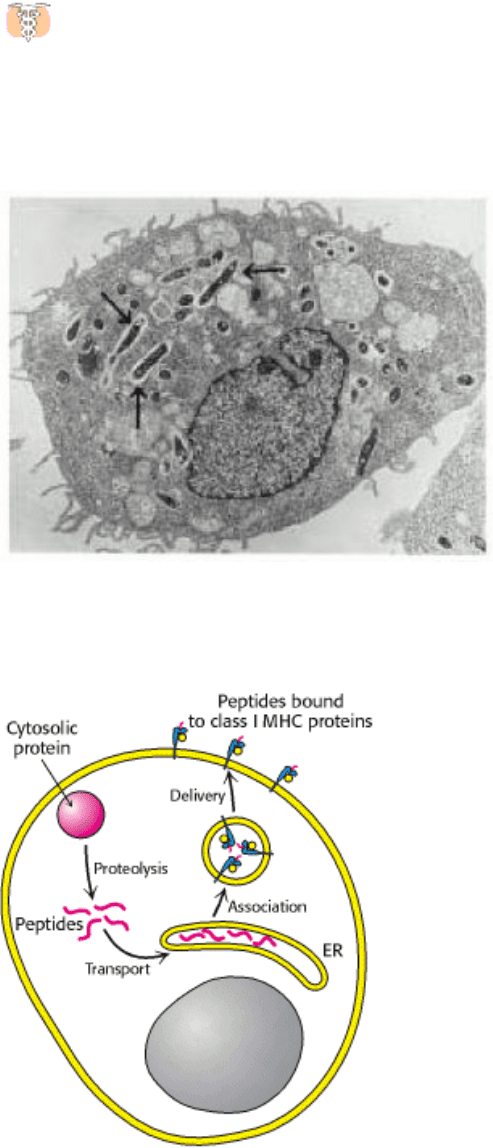
The development of an effective AIDS vaccine is difficult owing to the antigenic diversity of HIV strains. Because
its mechanism for replication is quite error prone, a population of HIV presents an everchanging array of coat
proteins. Indeed, the mutation rate of HIV is more than 65 times as high as that of influenza virus. A major aim now is to
define relatively conserved sequences in these HIV proteins and use them as immunogens.
IV. Responding to Environmental Changes 33. The Immune System 33.5. Major-Histocompatibility-Complex Proteins Present Peptide Antigens on Cell Surfaces for Recognition by T-Cell Receptors
Figure 33.21. Intracellular Pathogen. An electron micrograph showing mycobacteria (arrows) inside an infected
macrophage. [Courtesy of Dr. Stanley Falkow.]
IV. Responding to Environmental Changes 33. The Immune System 33.5. Major-Histocompatibility-Complex Proteins Present Peptide Antigens on Cell Surfaces for Recognition by T-Cell Receptors
Figure 33.22. Presentation of Peptides from Cytosolic Proteins. Class I MHC proteins on the surfaces of most cells
display peptides that are derived from cytosolic proteins by proteolysis.
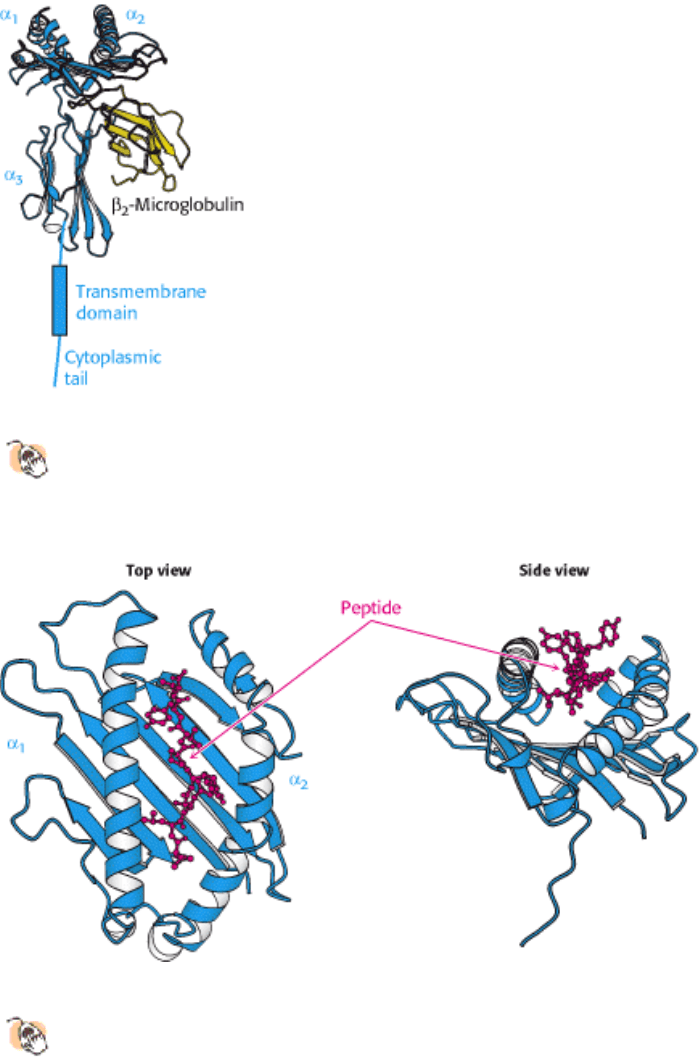
IV. Responding to Environmental Changes 33. The Immune System 33.5. Major-Histocompatibility-Complex Proteins Present Peptide Antigens on Cell Surfaces for Recognition by T-Cell Receptors
Figure 33.23. Class I MHC Protein.
A protein of this class consists of two chains. The α chain begins with two
domains that include α helices (α
1
, α
2
), an immunoglobulin domain (α
3
), a transmembrane domain, and a
cytoplasmic tail. The second chain, β
2
-microglobulin, adopts an immunoglobulin fold.
IV. Responding to Environmental Changes 33. The Immune System 33.5. Major-Histocompatibility-Complex Proteins Present Peptide Antigens on Cell Surfaces for Recognition by T-Cell Receptors
Figure 33.24. Class I MHC Peptide-Binding Site.
The α
1
and α
2
domains come together to form a groove in which
peptides are displayed. The two views shown reveal that the peptide is surrounded on three sides by a β sheet and
two α helices, but it is accessible from the top of the structure.
IV. Responding to Environmental Changes 33. The Immune System 33.5. Major-Histocompatibility-Complex Proteins Present Peptide Antigens on Cell Surfaces for Recognition by T-Cell Receptors
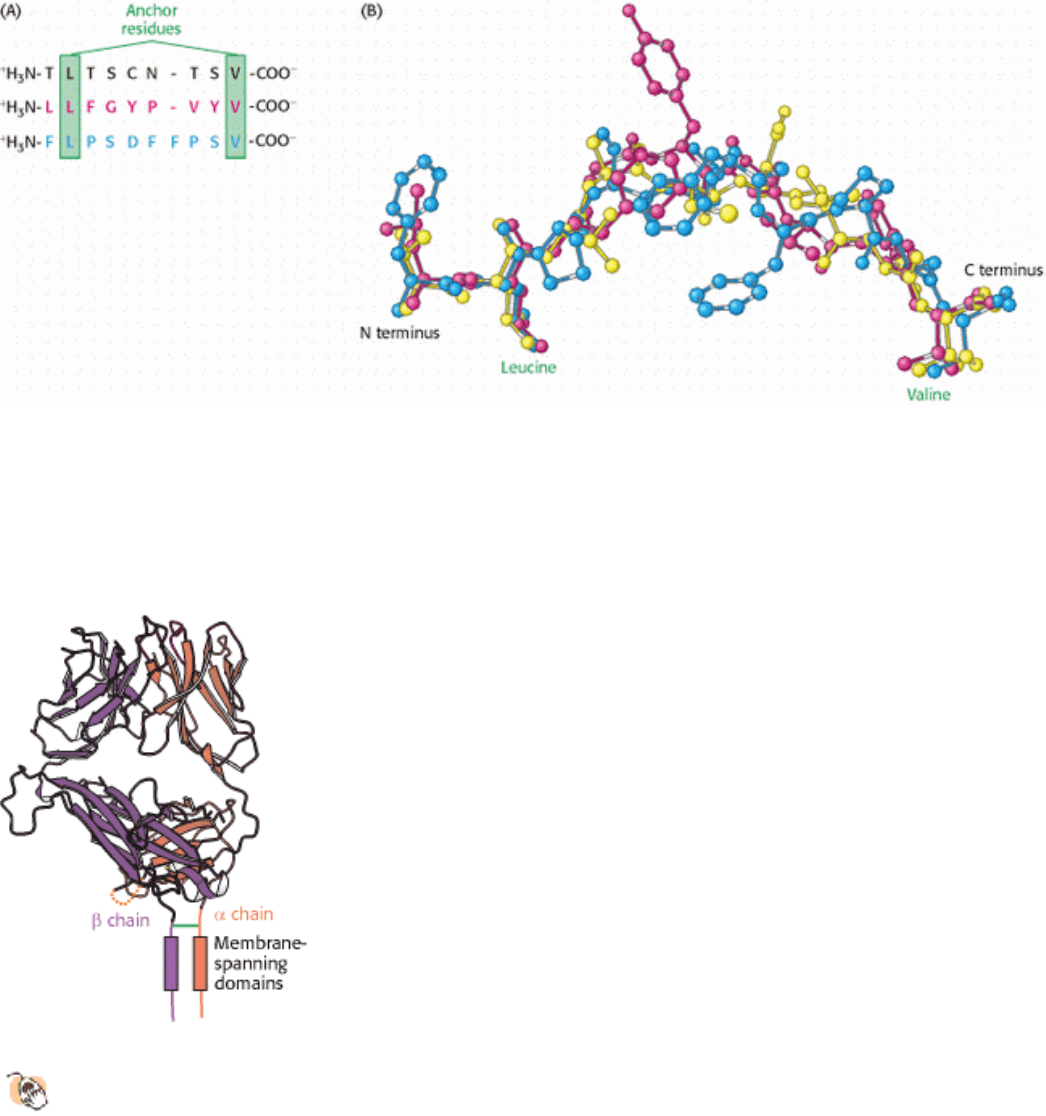
Figure 33.25. Anchor Residues. (A) The amino acid sequences of three peptides that bind to the class I MHC protein
HLA-A2 are shown. Each of these peptides has leucine in the second position and valine in the carboxyl-terminal
position. (B) Comparison of the structures of these peptides reveals that the amino and carboxyl termini as well as the
side chains of the leucine and valine residues are in essentially the same position in each peptide, whereas the remainder
of the structures are quite different.
IV. Responding to Environmental Changes 33. The Immune System 33.5. Major-Histocompatibility-Complex Proteins Present Peptide Antigens on Cell Surfaces for Recognition by T-Cell Receptors
Figure 33.26. T-Cell Receptor.
This protein consists of an α chain and a β chain, each of which consists of two
immunoglobulin domains and a membrane- spanning domain. The two chains are linked by a disulfide bond.
IV. Responding to Environmental Changes 33. The Immune System 33.5. Major-Histocompatibility-Complex Proteins Present Peptide Antigens on Cell Surfaces for Recognition by T-Cell Receptors
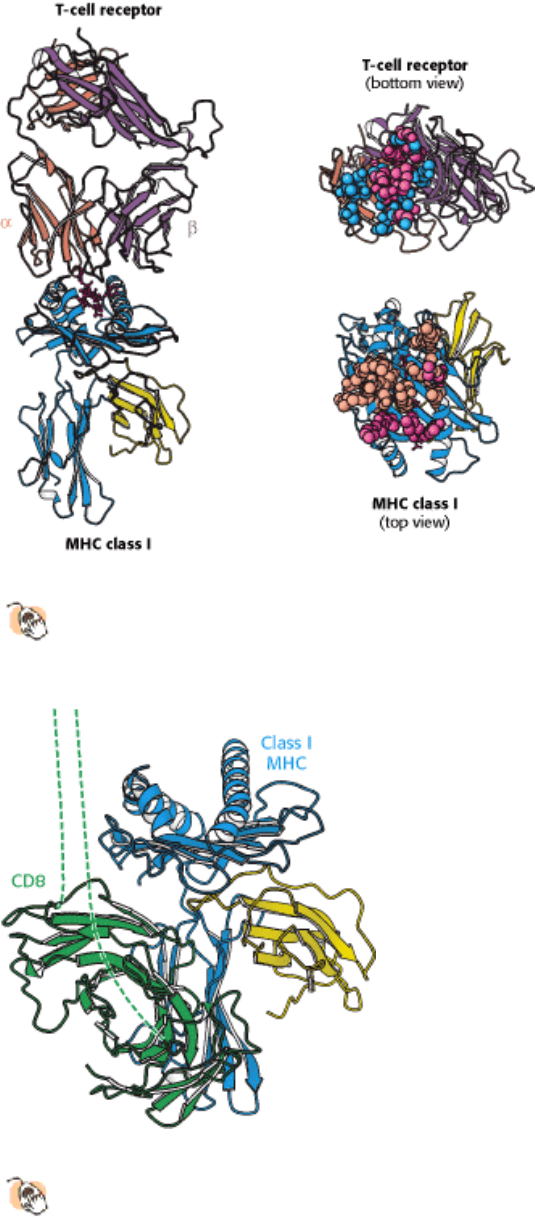
Figure 33.27. T-Cell Receptor Class I MHC Complex.
The T-cell receptor binds to a class I MHC protein containing a
bound peptide. The T-cell receptor contacts both the MHC protein and the peptide as shown by surfaces exposed
when the complex is separated (right). These surfaces are colored according to the chain that they contact.
IV. Responding to Environmental Changes 33. The Immune System 33.5. Major-Histocompatibility-Complex Proteins Present Peptide Antigens on Cell Surfaces for Recognition by T-Cell Receptors
Figure 33.28. The Coreceptor CD8.
This dimeric protein extends from the surface of a cytotoxic T cell and binds to
class I MHC molecules that are expressed on the surface of the cell that is bound to the T cell. The dashed lines
represent extended polypeptide chains that link the immunoglobulin domain of CD8 to the membrane.
